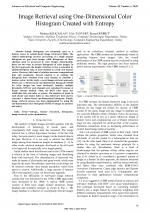| 2/2020 - 10 |
Image Retrieval using One-Dimensional Color Histogram Created with EntropyKILICASLAN, M. |
| Extra paper information in |
| Click to see author's profile in |
| Download PDF |
Author keywords
entropy, feature extraction, histograms, image retrieval, vector quantization
References keywords
image(34), retrieval(22), content(10), quantization(7), entropy(7), histogram(6), vector(5), systems(5), method(5), information(5)
Blue keywords are present in both the references section and the paper title.
About this article
Date of Publication: 2020-05-31
Volume 20, Issue 2, Year 2020, On page(s): 79 - 88
ISSN: 1582-7445, e-ISSN: 1844-7600
Digital Object Identifier: 10.4316/AECE.2020.02010
Web of Science Accession Number: 000537943500010
SCOPUS ID: 85087460177
Abstract
Image histograms are frequently used as a feature vector in content-based image retrieval (CBIR). The related methodology involves processing of a single channel histogram on gray level images while histograms of three channels must be processed in color images. Subsequently, there are two ways to process histograms of color images. In the first approach, the length of feature vector is extended by adding histogram data of each channel to create new feature vector. However, this kind of solution increases computational time and complexity. Second solution is to combine the histogram data obtained from each channel to establish a feature vector. In this study, a novel image retrieval approach, which uses a cluster-based one-dimensional histogram (ODH) for color images has been developed. Initially, multiple thresholds (MT) for each channel were calculated by means of Kapur entropy method. Then, the RGB color space was subdivided into sub-cubes or prisms. The numbers of pixels in each cluster and cluster index or class label have been used to construct a cluster-based one-dimensional histogram. Finally, image retrieval process has been implemented by using the one-dimensional color histogram (ODH) of images in database and query. |
| References | | | Cited By |
Web of Science® Times Cited: 5 [View]
View record in Web of Science® [View]
View Related Records® [View]
Updated today
SCOPUS® Times Cited: 6
View record in SCOPUS® [Free preview]
View citations in SCOPUS® [Free preview]
[1] Spiking neural network-based edge detection model for content-based image retrieval, İncetas, Mürsel Ozan, Arslan, Rukiye Uzun, Signal, Image and Video Processing, ISSN 1863-1703, Issue 2, Volume 19, 2025.
Digital Object Identifier: 10.1007/s11760-024-03799-6 [CrossRef]
[2] SNN tabanlı çok seviyeli eşikleme ile görüntü erişimi, İNCETAŞ, Mürsel Ozan, KILIÇASLAN, Mahmut, RAHKAR FARSHİ, Taymaz, Gümüşhane Üniversitesi Fen Bilimleri Enstitüsü Dergisi, ISSN 2146-538X, 2022.
Digital Object Identifier: 10.17714/gumusfenbil.1002577 [CrossRef]
[3] Neuromorphic computing spiking neural network edge detection model for content based image retrieval, Ambuj, , Machavaram, Rajendra, Network: Computation in Neural Systems, ISSN 0954-898X, 2024.
Digital Object Identifier: 10.1080/0954898X.2024.2348018 [CrossRef]
[4] Hybrid Machine Learning for Automated Road Safety Inspection of Auckland Harbour Bridge, Rathee, Munish, Bačić, Boris, Doborjeh, Maryam, Electronics, ISSN 2079-9292, Issue 15, Volume 13, 2024.
Digital Object Identifier: 10.3390/electronics13153030 [CrossRef]
[5] 光照不均图像的非线性自适应增强算法, Hong Yan, 洪炎, Pang Rong, 庞荣, Wei Qing, 魏青, Su Jingming, 苏静明, Zhao Feng, 赵峰, Laser & Optoelectronics Progress, ISSN 1006-4125, Issue 16, Volume 60, 2023.
Digital Object Identifier: 10.3788/LOP222380 [CrossRef]
Disclaimer: All information displayed above was retrieved by using remote connections to respective databases. For the best user experience, we update all data by using background processes, and use caches in order to reduce the load on the servers we retrieve the information from. As we have no control on the availability of the database servers and sometimes the Internet connectivity may be affected, we do not guarantee the information is correct or complete. For the most accurate data, please always consult the database sites directly. Some external links require authentication or an institutional subscription.
Web of Science® is a registered trademark of Clarivate Analytics, Scopus® is a registered trademark of Elsevier B.V., other product names, company names, brand names, trademarks and logos are the property of their respective owners.
Faculty of Electrical Engineering and Computer Science
Stefan cel Mare University of Suceava, Romania
All rights reserved: Advances in Electrical and Computer Engineering is a registered trademark of the Stefan cel Mare University of Suceava. No part of this publication may be reproduced, stored in a retrieval system, photocopied, recorded or archived, without the written permission from the Editor. When authors submit their papers for publication, they agree that the copyright for their article be transferred to the Faculty of Electrical Engineering and Computer Science, Stefan cel Mare University of Suceava, Romania, if and only if the articles are accepted for publication. The copyright covers the exclusive rights to reproduce and distribute the article, including reprints and translations.
Permission for other use: The copyright owner's consent does not extend to copying for general distribution, for promotion, for creating new works, or for resale. Specific written permission must be obtained from the Editor for such copying. Direct linking to files hosted on this website is strictly prohibited.
Disclaimer: Whilst every effort is made by the publishers and editorial board to see that no inaccurate or misleading data, opinions or statements appear in this journal, they wish to make it clear that all information and opinions formulated in the articles, as well as linguistic accuracy, are the sole responsibility of the author.



